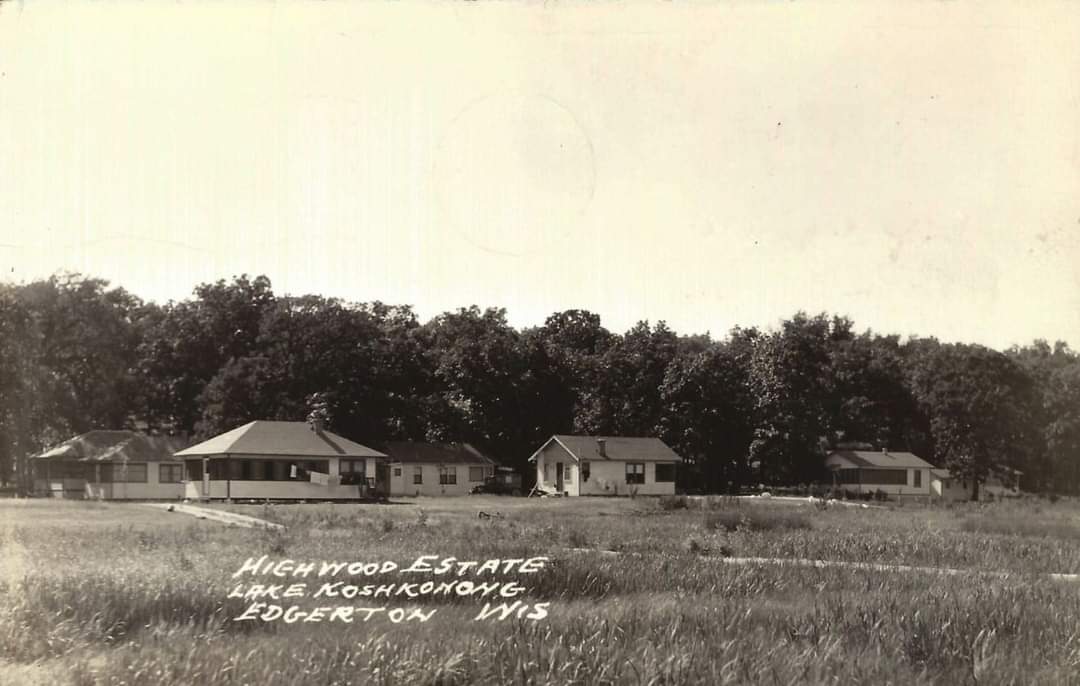History
Highwood Estates: A PARTIAL Historical Overview
 (Courtesy of Dan Conderman)
(Courtesy of Dan Conderman)
Early Beginnings
D.C. Noe and Initial DevelopmentHighwood Estates, nestled on the picturesque shores of Lake Koshkonong in Wisconsin, boasts a rich and intricate history that traces back to the vision of David C. Noe. Noe, a prominent businessman and landowner, held substantial land in the Lake Koshkonong area. His foresight in developing and subdividing this land laid the groundwork for what would become Highwood Estates. Before transforming into a residential community, the area primarily served agricultural and recreational purposes. It was a place where the natural beauty of the lake and its surroundings could be enjoyed by fishermen and outdoor enthusiasts. D.C. Noe saw the potential to develop this land into a desirable residential community, creating an appealing environment for both seasonal and permanent residents. Noe's efforts included plotting the land into lots suitable for homes and establishing necessary infrastructure to support a residential community. This initial vision and development by Noe were instrumental in shaping the future of Highwood Estates.
The Early 20th Century
The 1930s: The Boom of Highwood EstatesThe 1930s marked a significant period of growth for Highwood Estates. A notable article from December 31, 1937, in the Sky View Story of Southern Wisconsin, highlights the rapid development of the community. During this period, a lively community made up of several thousand Illinois residents and people employed in Edgerton began to flourish on the southwest shores of Lake Koshkonong. What was once a small summer resort, covering only a few hundred feet of lake frontage, expanded into one of the most interesting and colorful unincorporated villages in southern Wisconsin. Within a few years, more than 400 new cottages and homes were erected, transforming the area into a vibrant community. This transformation was guided by strict land contract regulations affecting the new subdivisions such as Highwood and Mallwood Estates and Hickory Hill. The Lakewood Developer's Association of Chicago, led by Nat Malnick, played a crucial role in this transformation. The association’s efforts attracted numerous residents, particularly from Illinois, who sought the serene and recreational benefits of the lake. Infrastructure and Amenities By the late 1930s, Highwood Estates had established itself as a well-organized community with modern amenities. Many homes were equipped with electricity and modern heating systems. The area boasted facilities such as electric hot water heaters, electric ranges, running water, and electric lights, which were considered luxuries at the time. The Wisconsin Conservation Department also contributed to the community by stocking Lake Koshkonong with various fish species, ensuring the lake remained an attractive destination for fishing enthusiasts. The department's efforts included the distribution of millions of fish fry and fingerlings, enhancing the lake’s ecosystem and recreational appeal. Mid-20th Century Developments Electricity and Modern Conveniences In 1931, Highwood Estates received electric power, marking a significant milestone in the community's development. This advancement brought modern conveniences to residents, enhancing the quality of life and making Highwood Estates an even more attractive place to live.
The 1950s: Challenges and Compromises
The 1950s were a period of both challenges and growth for Highwood Estates. A notable issue was the debate over the implementation of a sewer system. Many residents opposed the idea, preferring to maintain their private roads and resist transferring upkeep responsibilities to the Town of Albion. A 1956 article highlights the community’s resistance to a sewerage system and disposal plant. The Highwood Improvement Association argued that their compliance with state health and sanitation laws should exempt them from the proposed maintenance costs. They also highlighted the health hazards posed by inundated blocks, breeding mosquitoes, and the dumping of dead animals. Despite the opposition, a compromise was eventually reached, although the practice of dumping raw sewage into Lake Koshkonong remained a significant environmental concern. Legal Battles Over Road Maintenance In 1958, a legal battle ensued over the maintenance of roads in Highwood Estates. The Dane County Circuit Court ruled that the Albion Town Board acted legally in denying a petition to have town streets declared public roads. Residents argued that the streets had been open to the general public for over 20 years, but the court upheld the town board’s decision, stating the streets were not public property. This ruling meant that the 134 residents of Highwood Estates, who had fought a three-year battle since July 15, 1955, lost their appeal to have the town maintain their roads. The town board contended that the streets were not public property because Highwood Estates residents had posted “private drive” signs along them. The board also claimed that the 20-foot platted streets could not be reconstructed to meet the requirements of town roads, which must be at least three rods (49½ feet) wide. New Clubhouse and Community ImprovementsIn 1978, Highwood Estates embarked on a significant project to build a new clubhouse. This initiative, completed around 1982, provided a modern facility for community events and gatherings. The new clubhouse became a focal point for the community, hosting various social events and activities, and serving as a symbol of the community’s progress and cohesion. The new clubhouse not only offered a space for social gatherings but also housed amenities that enhanced the residents' quality of life. Over the years, the clubhouse has witnessed numerous events, from community meetings and fundraisers to social gatherings and celebrations, fostering a strong sense of community among residents.